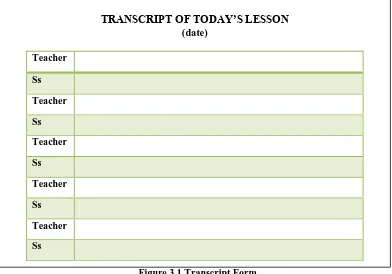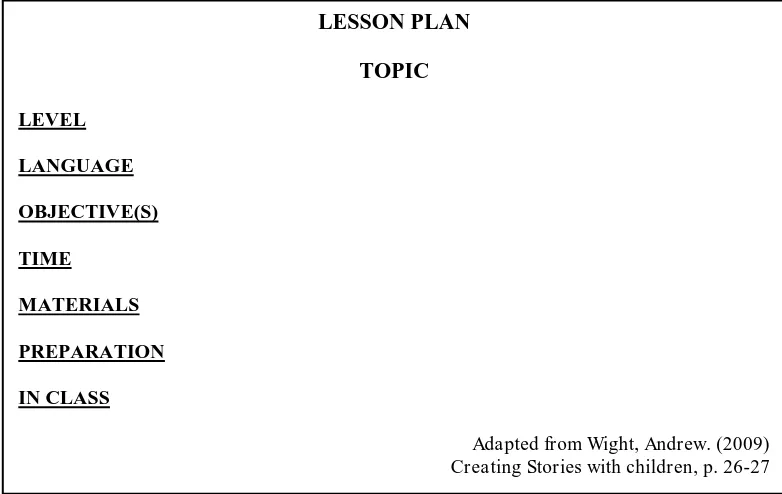Yuliani Arifin, 2015
CHAPTER III
RESEARCH METHODOLOGY
This chapter describes methodological aspects of the present study. Four main aspects of the research will be discussed: firstly, research design; secondly, research site; thirdly, data collection; and lastly, data analysis. The qualitative design is used in this research by employing case study. The three instruments of data collections: classroom observation, interview and survey questionnaire are also used to collect data and information to answer the research question.
3.1 Research Design
This research employed qualitative research design in the hopes to acquire more understanding about how the storyline method is implemented in teaching vocabulary and to find out students‟engagement towards storyline method. According to Burns (1995, p. 238), qualitative research facilitates access to individual meaning in the context of ongoing daily life. In account to that fact, the appropriate design method to implement is a case study. It is defined that a case study aims to investigate answers to specific research questions and to seek a range of different kinds of evidence to get the best possible answers to the research questions related to the contemporary phenomenon in real life event (Gilham, 2000; Yin, 2002; Burns, 1995).
Some researchers prefer this method due to a belief that “reality is multiple, contradictory, and changing better suited for exploring issues rich in context (Hord, 2009). Moreover, it is appropriately used to understand the phenomenon and situation holistically (Kumar, 2014).
of study. It is assumed that single case research measures the behavior of the subject or subjects at two or more points in time. (Nunan, 1991, p. 82; Emilia, 2009). It means that everything appears in the process of students‟ learning will be considered as important in the study.
This study used triangulation data collection method; classroom observation, interview and survey questionnaire, aimed to enhance the construct validity of the study and to gain more complete accounts to investigate the values and effectiveness of the teaching program implemented. In the study, the researcher was as participant observation who acted as the teacher in this storyline approach implementation. It will help gaining information more accurate and thorough (Fraenkell, Wallen, Hyun, 1932, p. 446).
3.2 Research Site
The study was conducted in SD Lab School UPI Bandung. It was chosen due to accessibility and practicality in conducting the research. The researcher took a purposive sampling in selecting participants. It is based on consideration of the population that the researcher study and choose sample carefully (Silverman, 2005, p. 129). One class of fourth grader students was chosen as participants of the study. The participant of this study was 31 students whose ages range between 9 and 11 years old that had different English language level.
The study conducted along the regular schedule in the school. During the research, the researcher would act as participant observer as the teacher. The data would be collected in five weeks. It will be elaborated below.
2014
3.3 Data Collection Method
To collect the data, the writer relied on qualitative methods to find out the teacher‟s way to teach vocabulary to young learners through storyline approach using triangulation method instruments. It is claimed that using a combination of methodological triangulation gives advantages for the researchers in two ways:(1) reducing risks of limited conclusion in particular method and sources; (2) increasing conclusion validity to widen the area (Alwasilah, 2002, p. 150). Classroom observation, interview and survey questionnaire results are the main sources of data collection and each of which is described below.
3.3.1 Classroom Observation
In this research, the main aspects of classroom observation became the writer‟s priority scale to observe. The main aspects mentioned above are formulated as follows,
Table 3.2
Observation Aspects
Focus Descriptions
Storyline The headings of chapter/ or the name of the story
Key Questions The key Questions used every episode
Activities Different kinds of activities practiced to answer the stated key questions
Organization the best organization for teacher‟s activities-pair work, group work, class work-in the class
Vocabulary Teaching Vocabulary teaching and its techniques
Resources/Materials resources used in particular activity
Outcomes end products at the end of each activity.
(Adapted from Harkness, 2007:21)
3.3.1.1 Field note
Table 3.3
An Example of Field note
No. Observed Teacher Activities
Observed Students Response
Comments
3.3.1.2 Documentary Data (classroom transcription record)
TRANSCRIPT OF TODAY’S LESSON
(date)
Teacher
Ss
Teacher
Ss
Teacher
Ss
Teacher
Ss
Teacher
Ss
Figure 3.1 Transcript Form
LEVEL
LANGUAGE
OBJECTIVE(S)
TIME
MATERIALS
PREPARATION
IN CLASS
Adapted from Wight, Andrew. (2009) Creating Stories with children, p. 26-27
Figure 3.2 Lesson Plan Form
3.3.2 Survey questionnaire and interview
This study gained more information about the students‟ aspects of engagements in the lesson through survey questionnaire and interview for primary school level. Therefore, survey questionnaire for primary level was collected at the end of storyline episode. They represented information to know students „engagements toward teaching vocabulary through storyline approach. According to Park (as cited in Pinter, 2006), children aged seven to twelve may simply misunderstand English language used in the questionnaire. In account for that fact, the researcher asked students‟ engagement about learning vocabulary through storyline and the activities they liked and did not by arranging close ended question in Bahasa for them. By using close ended question, researcher could save the limited time in conducting it and avoid nonsensical answer by students.
In interview, Alwasilah (2000, p. 154) argues that it helps the researcher to gain unavailable information from observation. He also adds that it provides in-depth information about the subject. The researcher only took 10 interviewee samples for the study. The interviews were based on the guidelines which have similar points with the questionnaire that they answered before. The questions covered information about students‟ aspects of engagements with the storyline learning process that they had and the vocabulary learning through storyline approach. The researcher also asked some questions related to students‟ hopes for the next storyline they want.
3.4 Data Analysis Method
In qualitative design, researcher is suggested to analyze the data as soon as the observation is done (Alwasilah, 2002, p. 158). It means that during the process of collecting all data, researcher analyzes one by one result of observation either it is from field notes or video transcript. Thus, it helps the researcher to prevent loosing visual details that might be important. Data analyses and interpretation were based on data mainly from observation that consists of classroom observation, interview and survey questionnaire. Miles and Huberman (as cited in Silverman, 2005, p. 177-178) suggests that there are three data analysis activity flows: data reduction, data display and conclusion drawings.
1. Data reduction is the process to select, focus, simplify, abstract, and transform the raw data from collected data of field note and video transcription. In this study, the collected data were read and reviewed before and after it was collected to be analyzed further in order to answer the research question of how the storyline approach is implemented in vocabulary teaching. In terms of students‟ interviews and survey questionnaires, the results are analyzed and classified into some categories related to the main focus of the aspects of engagement displayed during the activities in storyline approach.
conclusion drawing and action taking. This study, field notes, video transcription, questionnaire and interview were presented in tables and also extended text.
3. Conclusion drawing. The researcher then made an interpretation of the data analyzed and the conclusions and recommendations were also drawn for further research.
3.5. Concluding remark



